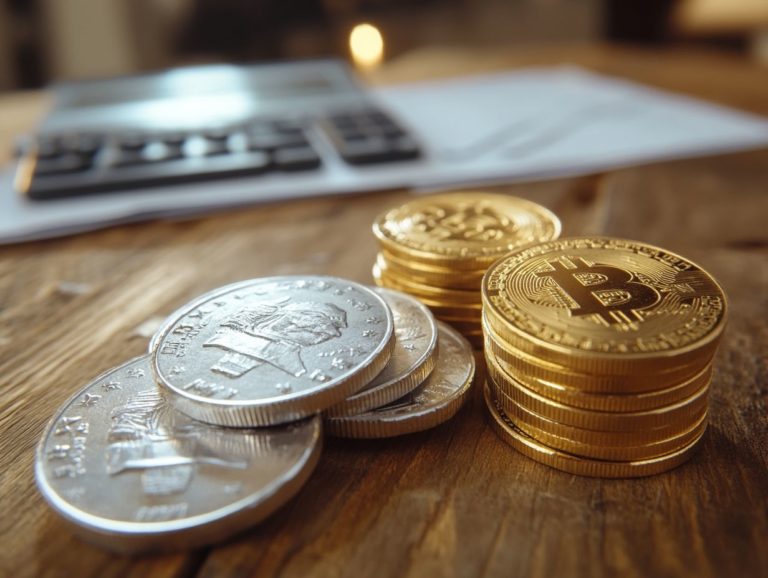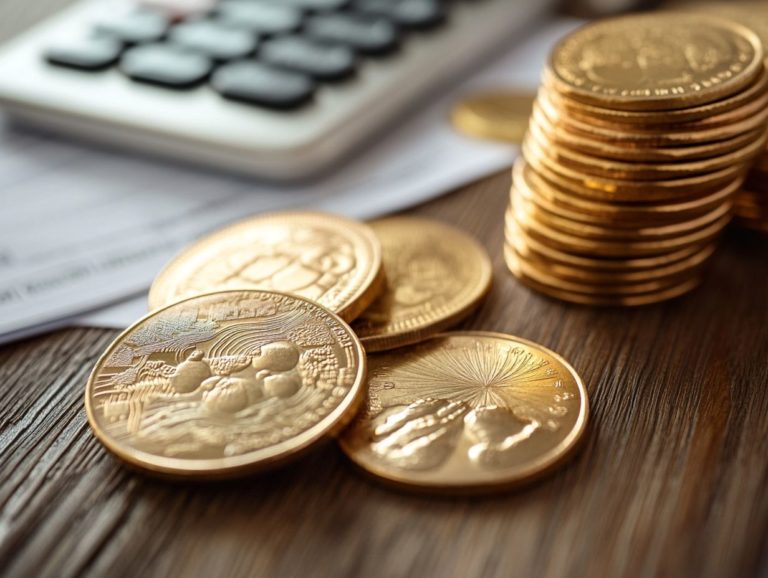Tax Implications of Buying and Selling Precious Metals
Investing in precious metals can be rewarding. However, understanding tax implications is essential to maximize your returns.
This article covers the basics of precious metals. We will highlight key reasons to consider them for your investment portfolio.
You will understand the tax ramifications of buying and selling these assets, including profit from sales and reporting requirements.
Additionally, discover strategies to minimize your tax liability. By understanding these aspects, you can make informed investment decisions.
Contents
- Key Takeaways:
- Tax Implications of Buying Precious Metals
- Tax Effects of Selling Precious Metals
- Strategies for Minimizing Tax Liability
- Frequently Asked Questions
- What are the tax implications of buying and selling precious metals?
- Is the tax rate different for different types of precious metals?
- Are there any tax exemptions for buying and selling precious metals?
- Do I need to report my precious metal transactions to the IRS?
- Can I offset my capital gains on precious metals with capital losses on other assets?
- Are there any tax implications if I inherit precious metals?
Key Takeaways:
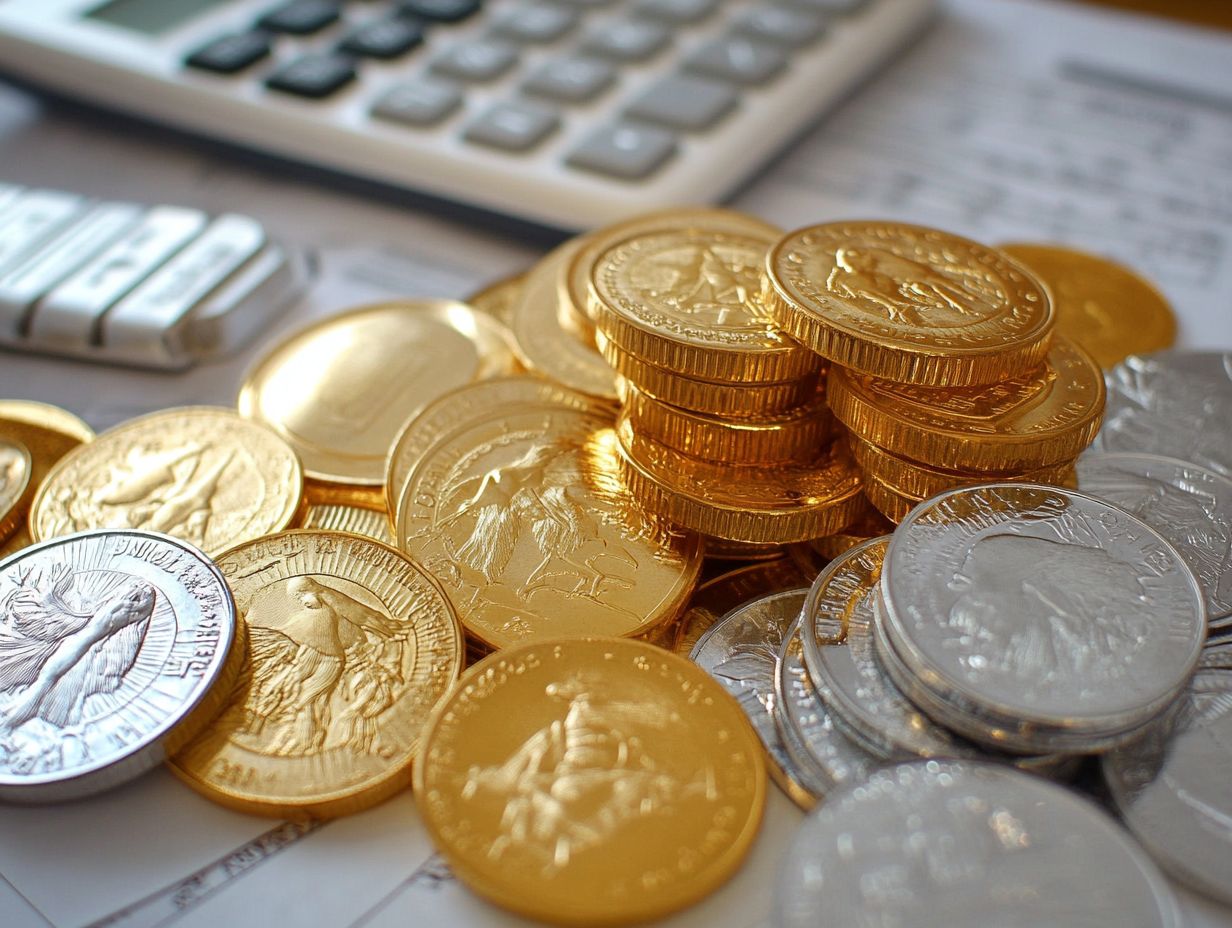
What are Precious Metals?
Precious metals gold, silver, platinum, and palladium are valuable natural resources. They are a reliable hedge against inflation and economic uncertainty.
You can acquire them as bullion, coins, or through various investment vehicles. This helps build a diversified investment portfolio that boosts your financial security.
Historically, these metals symbolize wealth and power. They have played significant roles in currency and jewelry, underscoring their cultural and economic importance.
In today s market, smart investors often include physical assets like gold bullion or silver rounds in their strategies. This gives you a tangible way to safeguard your wealth.
The trading landscape for precious metals is always changing. Factors like market demand, geopolitical events, and economic trends shape it.
With online trading platforms, you can explore various investment options, like exchange-traded funds (ETFs) and mining stocks. This enhances the versatility of your portfolio.
Why Invest in Precious Metals?
Investing in precious metals is a smart choice, especially during economic uncertainty or inflation. These assets provide safety and the potential for profit.
By allocating part of your portfolio to gold, silver, or platinum, you protect your wealth. Precious metals typically have lower correlations with stocks and bonds, making them great for diversification.
As inflation rises, these tangible assets can help maintain your purchasing power over time. Navigating this investment landscape can be complex; consider working with an investment advisor for tailored strategies.
Tax Implications of Buying Precious Metals
Understanding the tax implications of buying precious metals is crucial for investors. The IRS views these assets as collectibles, impacting your tax treatment.
This distinction can significantly affect your tax planning strategies.
Capital Gains Tax
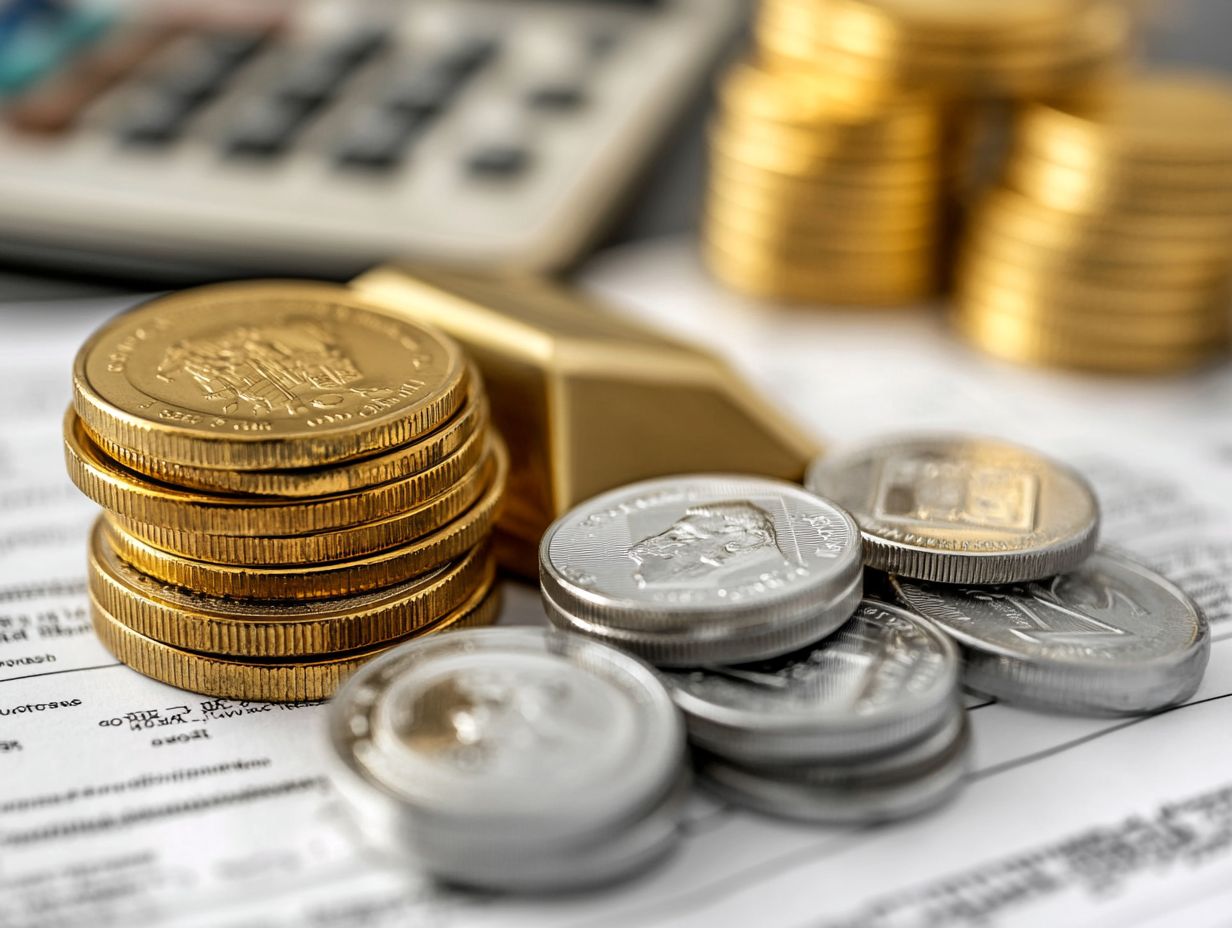
Capital gains tax applies to profits made from selling precious metals. It’s important to understand the differences between long-term and short-term gains. These classifications affect the tax rate you face from the IRS.
When selling precious metals like gold or silver, how long you hold the asset plays a key role in your tax effects. If you hold your investment for one year or less, it’s typically considered a short-term capital gain, taxed at your regular tax rate. Conversely, assets held for more than a year qualify as long-term capital gains, potentially leading to lower tax rates. It’s crucial to understand tax reporting for precious metals investments to navigate these implications effectively.
Understanding these distinctions helps manage your tax liability and impacts your overall investment strategy. Precious metals can be a significant asset class for many investors.
Reporting Requirements
If you invest in precious metals, you must follow specific reporting requirements set by the IRS. This ensures accurate income reporting and compliance with your tax returns.
These regulations are vital; they dictate the documents you need, such as purchase invoices and sales records. Keep in mind that reporting deadlines can vary, impacting your overall tax obligations.
Neglecting these rules threatens your financial integrity and could lead to fines or even legal action. Maintaining careful records and understanding legal requirements is crucial when buying and selling precious metals.
Tax Effects of Selling Precious Metals
When selling precious metals, understanding the specific tax effects is essential. Capital gains tax applies to profits made from sales, so equip yourself with strategies to manage your IRS obligations.
These nuances can significantly influence your investment journey.
Selling precious metals, like purchasing them, carries capital gains tax implications. Knowing the difference between long-term and short-term gains is essential for understanding your potential tax bill. For more details, check out the tax implications of selling your precious metals collection.
Gains from the sale can be classified as short-term or long-term, depending on how long you’ve held the assets. Short-term gains, which apply to metals held for a year or less, are taxed at ordinary income rates, potentially leading to a higher tax bill. Long-term gains benefit from favorable tax rates, but only if you’ve held the metals for over a year. It’s also important to consider the tax implications of selling precious metals to a dealer for a comprehensive understanding of how these gains are taxed.
This distinction can greatly affect your net returns. Strategic planning and timing are necessary when deciding to sell. Stay informed about additional tax obligations, like state taxes or reporting requirements, to optimize your financial strategy.
Reporting Requirements
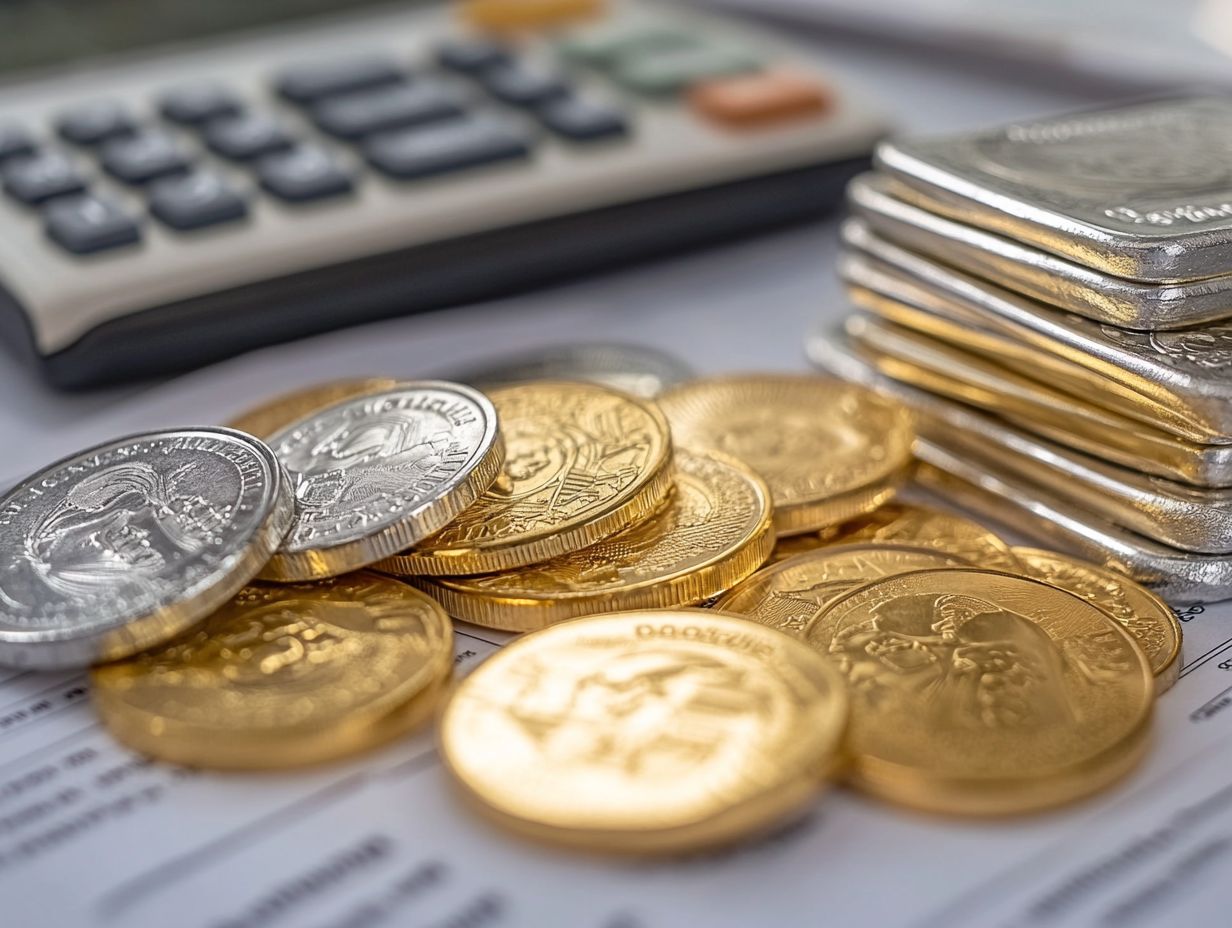
When selling precious metals, adhering to IRS reporting requirements is essential for accurate income reporting and meeting your tax return obligations.
This involves keeping detailed records of each transaction, including the date of sale, quantities, and types of metals exchanged. Be aware that specific documentation, like Form 1099-B, may be required if your sales exceed certain thresholds.
Accurately reporting gains on your tax returns is vital; failing to do so can result in severe penalties and interest charges. Understanding these obligations helps you avoid costly mistakes and ensures compliance with federal regulations.
Stay informed and save money start organizing your records today!
Strategies for Minimizing Tax Liability
Crafting effective strategies to minimize tax liability is crucial for you as an investor in precious metals. Thoughtful tax planning can profoundly impact your overall returns, ultimately enhancing your wealth accumulation over time.
Holding Periods and Tax Rates
Holding periods for precious metals play a pivotal role in determining the tax rates that apply to your investments. The length of time you retain these assets influences whether you face long-term or short-term capital gains tax obligations.
Understanding the significance of these holding periods is essential. If you hold precious metals for over a year, you may qualify for lower long-term capital gains rates, which can significantly enhance your returns compared to the higher rates linked to short-term holdings. For more detailed insights, explore tax strategies for precious metals in today’s market.
Now is the time to adopt a smart strategy, weighing the benefits of immediate liquidity against the potential tax implications over time. This consideration is especially relevant if you view precious metals as a hedge against inflation or currency fluctuations. By strategically planning around holding periods, you can work towards achieving a more favorable financial outcome.
Offsetting Gains with Losses
Using losses to reduce gains is an essential strategy for you as an investor in precious metals. It enables you to effectively manage your tax liability and optimize your overall investment performance.
By employing tax-loss harvesting techniques, you can strategically sell off underperforming assets to realize losses, which can then offset capital gains from your profitable trades. This approach reduces your taxable income and fosters a more balanced investment portfolio, helping you mitigate risks associated with market volatility.
To maximize your benefits, know the tax code, especially the wash sale rule. By integrating loss offsets into your broader financial strategy, you can strengthen your positions while enhancing your tax efficiency.
Frequently Asked Questions
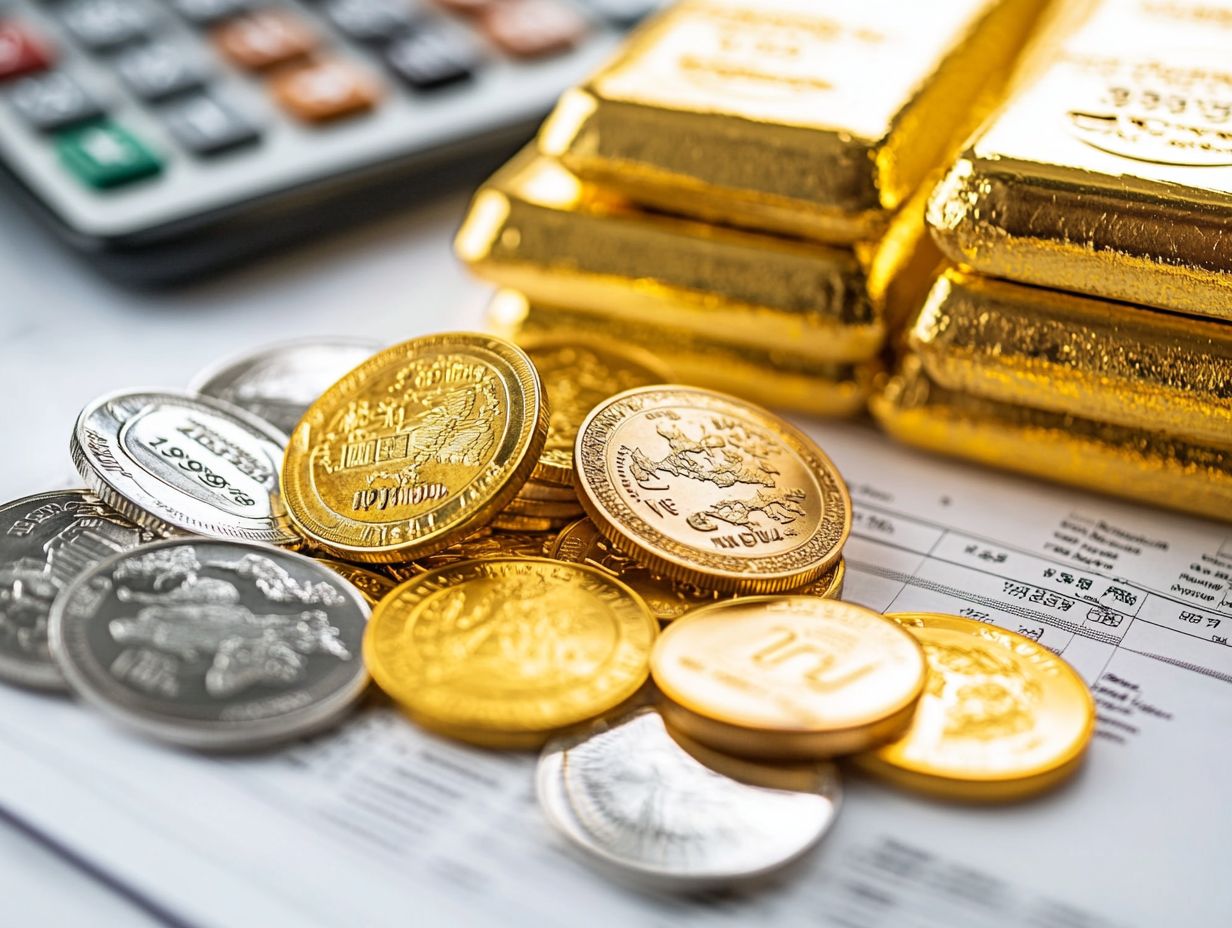
What are the tax implications of buying and selling precious metals?
The tax implications depend on factors such as the type of metal, the length of time you hold it, and your tax bracket. Generally, buying and selling precious metals is considered a capital asset and may be subject to capital gains tax.
Is the tax rate different for different types of precious metals?
Yes, the tax rate can vary. For example, gold and silver are subject to a 28% capital gains tax rate, while platinum and palladium are subject to a 15% capital gains tax rate.
Are there any tax exemptions for buying and selling precious metals?
Yes, there are certain tax exemptions. If you hold the metal for more than one year, you may be eligible for long-term capital gains tax rates, which are typically lower than short-term rates.
Do I need to report my precious metal transactions to the IRS?
Yes, you are required to report any buying or selling of precious metals on your tax return, including both gains and losses from these transactions.
Can I offset my capital gains on precious metals with capital losses on other assets?
Yes, you can offset your capital gains on precious metals with capital losses on other assets. This helps reduce your overall tax liability.
Are there any tax implications if I inherit precious metals?
Yes, if you inherit precious metals, you may be subject to inheritance tax or estate tax, depending on the size of the estate. It is important to consult with a tax professional for guidance on reporting and paying any applicable taxes.












